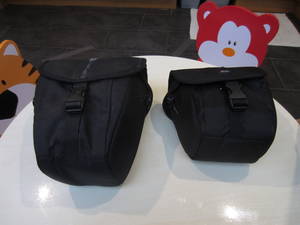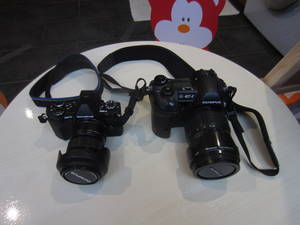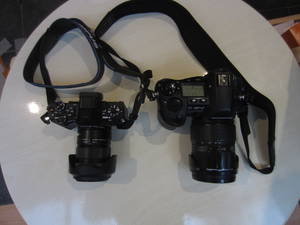I recently acquired my fourth digital camera, an Olympus E-M5 II. This is not a replacement for my third camera, a little Canon Ixus 220 HS point-and-shoot bought in 2012 which I will keep as a carry-everywhere camera (and with which I took the photos below), but for my second camera, an Olympus E-1 . That was released in 2003, so is now something of an antique, but is still a fine camera and I have no plans to get rid of it yet.
Physical Handling
The most triking difference is in the size and weight. Comparing the E-M5 and E-1 in the configuration I carry them most commonly, with the standard zoom lenses they came with (the 12-50mm f/3.5-6.3 and a 14-54mm f/2.8-3.5 respectively), in bags (Lowepro TLZ 10 and TLZ 20) with one spare battery and a basic external flash unit (FL-LM3 and FL-20), the E-M5 comes in at just over 1kg, the E-1 at 1.75kg. The difference in bulk means it's much easier to fit the E-M5 into the backpack I carry with me pretty much everywhere.
Out of the bag, without the flash units or the spare batteries, the weight difference is starker 0.71kg versus 1.31kg and the difference in bulk is dramatic, even though the lenses are roughly the same length and the lens hood seems big on the E-M5 (I have the cheap third-party hood).
Both cameras (and lenses) are dust- and rain-proof, and of solid metal construction. The E-M5 is just robust, however, where the E-1 was like a brick — especially with the big 50-200mm telephoto on it, it felt like it would be a real asset facing down a jackal. The E-M5 has 3 control dials plus a lever switch and 14 buttons (with another one on the lens), where the E-1 has the same dials and 26 buttons. A lot more control customisation is possible with the EM-M5, though, and it still seems that everything I need is easily accessible when shooting. Both cameras fit nicely in my hand, though I can imagine someone with large hands finding the E-M5 a bit awkward and someone with smaller hands than mine having trouble with the E-1.
The Viewfinder
The most fundamental difference (and the one responsible for much of the weight/size difference) is that where the E-1 is an SLR with a mirror and an optical viewfinder, the E-M5 has an electronic viewfinder (EVF). I was expecting this to be a major regression, but though there is a certain loss of immediacy the EVF refreshes fast enough for my purposes (a sports photographer might disagree, but it works fine for toddlers), shows enough detail with its 2.4 megapixels, and is (not being limited by the need for a pentaprism) simply bigger (148% instead of 96%, and with just enough eye relief to be usable with my glasses without corner loss). The EVF also allows for more useful information to be overlaid on the shooting display, in particular a live histogram (which means less chimping).
Having got the hang of the E-M5 controls and configured them how I want them, and with the superior viewfinder info, I find I hardly ever need to use the articulated LCD screen when shooting, and usually keep it folded in to protect it — I pretty much only use it for overhead photos and down-to-the-ground macro photography. (Though it is, being 3" in size instead of 1.8" and with a million pixels instead of 134,000, vastly better for replaying and evaluating photos.)
Everything Else
In every other aspect the newer camera, with twelve years of technological improvement behind it, naturally improves on the older one. There are also ways in which not having a mirror allows for a whole range of novel features to be provided.
When it comes to other aspects of shooting responsiveness, the EM-5's contrast autofocus is faster and seems to be just as accurate as the E-1's phase detection autofocus; it also copes better in low light. It has 81 focus points instead of 3, which I actually find a bit disconcerting, being used to "focus and frame" shooting; being able to choose individual focus points using the touchscreen LCD seems likely to only of use when shooting on tripod. And the intelligent face detection seems to work remarkably well.
Shooting jpegs, the E-M5 image quality is clearly better than my little Canon and an improvement on the E-1, but the colours are perhaps a little flat compared to the E-1 jpegs. That could just be the gloomy weather I've used it in so far and if not can presumably be improved by fiddling with the various colour settings. The upgrade from 5 megapixels to 16 helps here (though otherwise is of no great importance to me). And the E-M5 goes to ISO 1600 with quite reasonable quality (probably the equivalent of the E1's ISO 400) and the auto-ISO setting seems to do the right thing most of the time. That, plus the image stabilisation, makes for much better low-light photography. (A bucketload of photos taken with the E-1 can be found in my travelogues; most of my E-M5 photos are non-public photos of my toddler and her friends.)
The E-1 didn't do video at all. The E-M5 will do full HD video at 60fps; integrated with the lens, the image stabilisation and so forth, this produces quite spectacular videos.
See DPReview for a detailed comparison of the cameras
The Flashes
Neither camera has a built in flash. Between the better high-ISO capability and the image stabilisation, the E-M5 copes better without. But it also comes with a really nice micro-flash unit, the FL-LM3, which while it isn't that far off-axis for direct flash can rotate and swivel up, allowing for bounce-flash in both orientations. This is only 50gm, largely because it has no batteries of its own but draws power from the camera battery (by far the better solution in my opinion).
The Lenses
The old Four Thirds 14-54mm f/2.8-3.5 lens is faster, especially at the long end, which isn't so important for shutter speeds (the image stabilisation and the better high-ISO performance of the E-M5 more than compensate) but does make blurring backgrounds easier. And it has a tiny bit more reach. Otherwise the Micro Four Thirds 12-50mm f/3.5-6.3 is a fantastic lens. Its extra wide angle - 24mm equivalent instead of 28mm - is really nice (and stops the E-M5 being inferior to my little Canon). It has an internal zoom, so it doesn't extend while zooming, a choice between power and manual zoom. It also has even better macro capability than the quite decent 14-54, with a special macro mode with (35mm equivalent) magnification of 0.72x.
See DPReview for a detailed comparison of the lenses.
I've already picked up a cheap f/4-5.6 40-150mm telephoto, but am also tempted by a pancake lens (maybe the Panasonic 12-35mm f/3.5-5.6) and maybe a fast prime (most likely the 25mm f/1.8).




Yeah I bought the EM-10 earlier this year. Loving the M43 form factor. After a long time with only point and shoot compact cameras, it's quite a revelation that you can get so much quality without having to stump up for the cost and bulk on an SLR.
The live compositing feature is really fun for star trails like this: http://photos.simonrumble.com/Astronomy/Coolendel-2015/i-kc48nCs/A
You've got some nice photos there!
I'll have to try the compositing feature out one day. There are a bucketload of fancy features - also HDR, scene modes, options for use with a tripod, fancy video settings, and so forth - which I have only glanced at. My first month has basically been learning enough about the basic shooting controls and options to get me to where I was with the E-1, and to check if there were any major regressions.